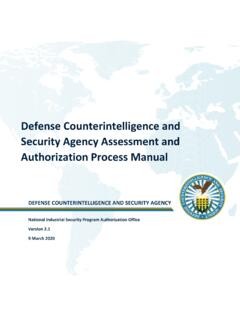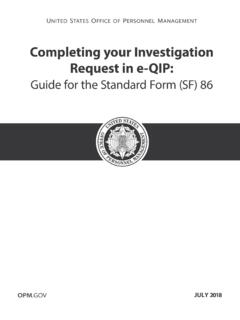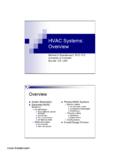Transcription of PROTECTED DISTRIBUTION SYSTEMS (PDS)
1 CNSSI September 2015 PROTECTED DISTRIBUTION SYSTEMS (PDS) THIS DOCUMENT PRESCRIBES MINIMUM STANDARDS YOUR DEPARTMENT OR AGENCY MAY REQUIRE FURTHER IMPLEMENTATION CNSS Secretariat (IE414) National Security Agency, 9800 Savage Road - Suite 6740 - Ft Meade MD 20755-6716 THIS PAGE INTENTIONALLY LEFT BLANK NATIONAL MANAGER FOREWORD 1. The Committee on National Security SYSTEMS (CNSS) issues this Instruction pursuant to its authority under National Security Directive 42, National Policy for the Security of National Security Telecommunications and Information SYSTEMS .
2 This Instruction provides guidance and requirements for the approval and installation of wire line and optical fiber DISTRIBUTION SYSTEMS used to protect unencrypted, National security information (NSI) through areas of lesser classification or control. 2. This Instruction supersedes National Security Telecommunications and Information SYSTEMS Security Instruction (NSTISSI) 7003, PROTECTED DISTRIBUTION SYSTEMS , dated 13 December 1996. 3. Additional copies of this Instruction may be obtained from the CNSS Secretariat or the Committee on National Security SYSTEMS website: FOR THE NATIONAL MANAGER: /s/ CURTIS W.
3 DUKES CNSSI No. 7003 i TABLE OF CONTENTS SECTION PAGE SECTION I - PURPOSE .. 1 SECTION II - AUTHORITY .. 1 SECTION III - SCOPE .. 1 SECTION IV - POLICY .. 2 SECTION V - RESPONSIBILITIES .. 3 SECTION VI - DEFINITIONS .. 3 SECTION VII - REFERENCES .. 4 SECTION VIII - GENERAL PDS INSTALLATION GUIDANCE .. 5 SECTION IX- CATEGORY 1 PDS INSTALLATION GUIDANCE .. 7 SECTION X - CATEGORY 2 PDS INSTALLATION GUIDANCE .. 8 SECTION XI - PDS INSPECTION .. 10 ANNEX ANNEX A - SAMPLE PROTECTED DISTRIBUTION SYSTEMS (PDS) APPROVAL A-1 ANNEX B - REFERENCES.
4 B-1 CNSSI No. 7003 1 PROTECTED DISTRIBUTION SYSTEMS (PDS) SECTION I - PURPOSE 1. This Instruction stipulates guidance and standards for the design, installation, and maintenance of PDS. This Instruction incorporates a philosophy of risk management in lieu of a risk avoidance . Absent specific facts unique to each facility suggesting greater or lesser risks, these standards shall be applied. This PDS guidance must be followed subject to discretion of the department or agency Authorizing Official (AO) who may act on facts unique to each facility suggesting greater or lesser risks.
5 The overall security afforded by a PDS is the result of a layered approach incorporating various protection techniques. Emphasis is placed on detection of attempted penetration in lieu of prevention of penetration. Criteria outlined in this Instruction are based on threat or risk analysis relative to the location of the PDS. This generally results in reduced requirements and potential cost savings during installation and maintenance of PDS. The decision as to what extent the guidance provided in SECTIONS VIII thru X is followed ultimately rests with the department or agency AO.
6 The PDS approval request identified in SECTION V, and outlined in ANNEX A, will describe the specifics of the PDS, including unique facts regarding the facility, installation details, and inspection methods and schedule. The AO must sign a formal written acceptance of risk for any deviations. SECTION II - AUTHORITY 2. The authority to issue this Instruction derives from NSD-42, which outlines the roles and responsibilities for securing national security SYSTEMS consistent with applicable law, Executive Order 12333, United States Intelligence Activities, as amended, and other Presidential directives.
7 3. Nothing in this Instruction will alter or supersede the authorities of the Director of National Intelligence (DNI). Information in the following sections and tables which relates to Sensitive Compartmented Information (SCI) is advisory to the DNI. SECTION III - SCOPE 4. This Instruction applies to Government (USG) departments, agencies and their contractors and vendors who use PDS to protect the transmission of unencrypted NSI. This Instruction provides guidance for PDS installed within low and medium threat locations worldwide as determined by the AO in consultation with the cognizant Certified TEMPEST Technical Authority (CTTA) and Counterintelligence Authority responsible for providing counterintelligence (CI) risk assessment.
8 The use of PDS within a high or critical threat location is not recommended. If PDS are used in these locations, protection techniques must be determined on a case-by-case basis by the AO in consultation with the cognizant CTTA and Counterintelligence Authority responsible for providing a CI risk assessment. The cognizant CTTA will provide the AO the TEMPEST requirements for the PDS based on the technical threat as determined by the CTTA. CNSSI No. 7003 2 5. The contents of this Instruction should be made available to personnel involved in the planning, acquisition, installation, approval, and operation of communications SYSTEMS that process classified NSI and use PDS.
9 SECTION IV - POLICY 6. PDS are used to protect all unencrypted NSI through areas of lesser classification or control. Inasmuch as the NSI is unencrypted, the PDS must provide adequate electrical, electromagnetic, and physical safeguards to deter exploitation. Careful consideration should be given to using encryption or establishing a Controlled Access Area (CAA) in lieu of a PDS. To minimize cost overruns, the threat environment, value of data being lost, risks, cost and operational impact of maintaining the security of the system should be assessed prior to PDS acquisition and installation.
10 7. The use of PDS within an Uncontrolled Access Area (UAA) is not permitted and National Manager approved encryption solutions must be employed. 8. Encryption solutions for secure multi-site connectivity which have been approved by the National Manager for National Security SYSTEMS (NSS) are the preferred methods for protecting NSI. 9. PDS must be installed in accordance with the guidance provided in SECTIONS VIII thru X and is subject to deviation at the discretion of the department or agency AO. 10. The AO must ensure PDS are inspected in accordance with SECTION XI and certified prior to initial operation.
















